Tuscany isn’t all about sipping wine and watching the sun set, as Amy McPherson discovers on an e-bike tour around Monte Amiata, in the region’s south
Photos by Ciclica Foto, Mario Llorca
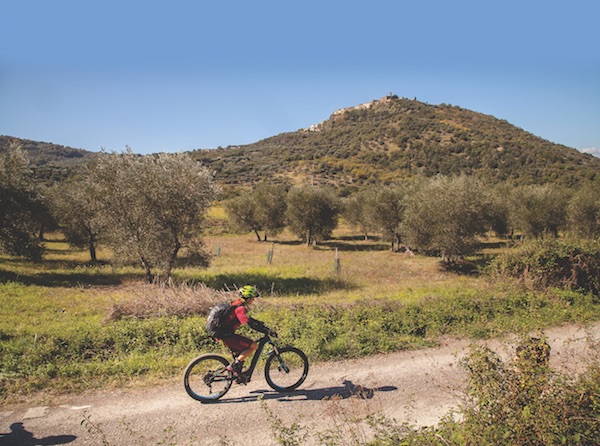
Giant moss-covered boulders rise in vertical stacks, as if someone was attempting to build a replica of the Leaning Tower of Pisa. It is almost too steep for me to stay upright on foot, let alone trying to balance on two wheels.
I know it will take herculean strength to ride all the way up this craggy hill on a bicycle. Cracks appear where the rocks collide, and unruly tree roots add challenges along the path. My natural instinct is to slow down and get around them, but by doing so I risk running out of leg power and having to reduce myself to the humiliation of walking. I know what to do, but I refuse to submit to cheating. Yet it seems the only way out. I have to make up my mind fast.
“Why did you slow down? Speed up! Keep going!” shouted Andrea, my guide from Amiata Freeride, as he came level with me. “Come on Amy, you know what to do!”
I knew Andrea was right. There was only one thing to do. I took a deep breath, reached for the e-bike’s power boost and hit ‘Turbo Assist’.
Tuscany is supposed to be about visiting vineyards, seeking out Renaissance masters in galleries in Pisa and Florence, spending lazy afternoons with glasses of wine while looking out to layers of gentle hills punctuated by cypress trees and watching as the colours of the day shifts when this landscape is awash with pink and gold hues at sunset.
Yet, it seems, even the most romantic destinations have their wild side. I am travelling through beech and chestnut forests on a mountain bike at a speed I never thought possible, and my heart is gripped by a mixture of excitement and fear. Never did I expect my first experience of Tuscany to be more James Bond than a Puccini aria. This is the Amiata Effect.
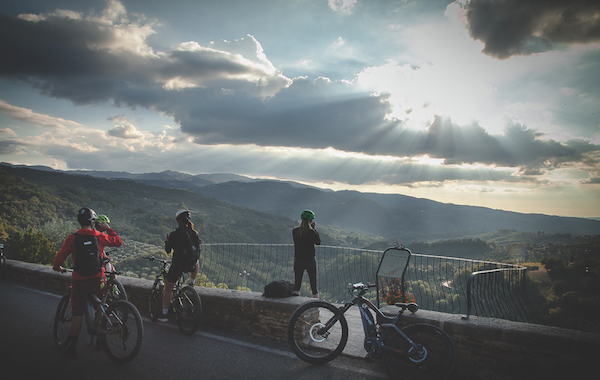
Adrenaline pumping
This adrenaline pumping adventure came with some initial hesitation. You see, as a regular cyclist, I have certain prejudices towards the idea of e-bikes. Cycling shouldn’t be easy. The fatigue, the muscle pain and the sharp breaths should be worth every stitch on my Lycra outfit. Until now, anything that make cycling easier, including e-bikes, was cheating in my books. So when I was handed an mountain e-bike on my visit to Mount Amiata to experience the wild side of Tuscany, I was reluctant to oblige.
“E-bikes are not like automatic scooters, you still have to work for it,” said Silvia Livoni, an experienced road cyclist on tour with us. She assures me that even the pros get on an e-bike once in a while.
“It also makes mountain biking so much more fun when you don’t have to worry about running out of power trying to get up a big rocky hill,” she winks. “You’ll see!”
As my bike rolled me up the steep rocky climb with considerably less effort than I had anticipated, making me feel a little like Superwoman, I did see. The benefits of not having to worry about my energy and strength reserves made the mountain biking experience so much more fun, especially when there is so much to see and experience along the way.
Mount Amiata is an ancient, dormant volcano south of Siena that has long shaped the landscape, and the lives of those who live on and around it. From mercury mines and buildings constructed by local volcanic rock to natural hot springs, there are reminders of the volcano’s existence in every corner of this region. And what better way to discover this wild environment than by mountain bike?
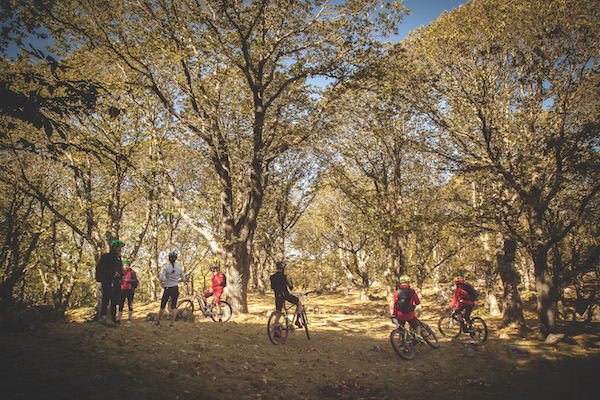
Young and old
I am cycling with Amiata Freeride, a mountain bike rental and tour company that also has classes to teach the young and the old the skills in mountain biking. We began our day with an hour-long mountain biking crash course to learn the basics of bike handling before setting off to explore Amiata through the woods.
Pushing off from our hotel, Le Macinaie, near the summit of Amiata, we wind our way along the leafy path and slowly descend into the surrounding forest, where the grounds are uneven with volcanic rock carpeted with thick green moss, and the clusters of straight-standing beech trees appear like soldiers standing sentry on the paths leading into the mountain’s heart.
I proceed tentatively at first, still bothered by the idea of being on an e-bike, but soon, my mind is distracted by the beauty of the landscape that surround me. Weaving in and out of forest trails, I spot castle towers in the distance in between the trees; I listen to the bells that chime through the mountain from churches beyond my vision, and smell the burning wood that has drifted from the nearby towns in the air.
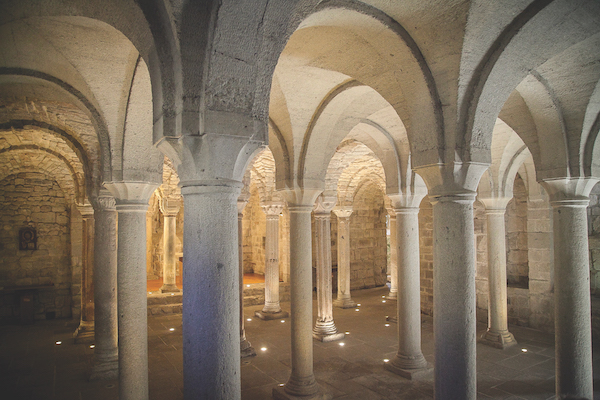
‘The Mother’
When speaking to the people of Amiata, everyone referred to the mountain as ‘the Mother’. It is the mountain that shelters, feeds and provides – and nowhere can you experience the close relationship between mountain and town’s people than on a visit to Abbadia San Salvatore.
To call Abbadia San Salvatore a volcanic universe is not too strong. The town has thrived on the products of Amiata for centuries and the mountain is as important to it now as it was in medieval times.
Having found parking for our bikes, we walk through the historical centre to visit the Abbey of San Salvatore. The Romanesque abbey exterior was built in 1035, but the crypt dates back to 792. The slightly darker shade of the stones show that, just like many of the buildings in the historical centre and in other nearby villages, the abbey was built with local volcanic rock. While the abbey has received numerous facelifts, certain religious and historical features have been preserved; notably the original wall paintings that tell the story of Abbadia San Salvatore as well as those of the martyrs Abdon and Sennen, whose ashes are kept at the foot of the murals.
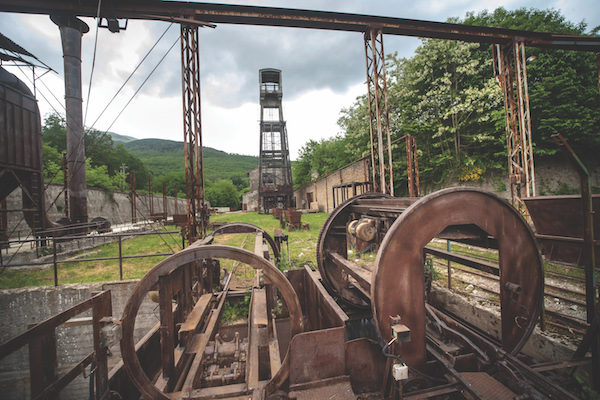
Cinnabar and mercury
A little outside the town is further evidence of how Amiata influences the lives and work of the local population. From 1899 to the mid-1970s, the mining of cinnabar and the refining of mercury from it was the centre of economic activity at Abbadia San Salvatore, and at the Mining Museum Park I learn all about the extraction and production processes, and glimpse the hard working conditions of the miners on board a mine wagon through a mining tunnel, where our museum guide tells us tales of accidents, deaths and the risks of contracting diseases from the constant inhalation of fumes and dust.
Back on our e-bikes, we make our way through the woods again and come across a chestnut forest, where I wave at the locals filling their baskets and sacks full of plump chestnuts to take home. Chestnuts are the basic ingredient for the local polenta recipe, and the tradition of chestnut picking and cuisine dates back to the 8th century. By the look of the smiles on these families out picking chestnuts, it looks like there will be plenty of polenta to go around this year.
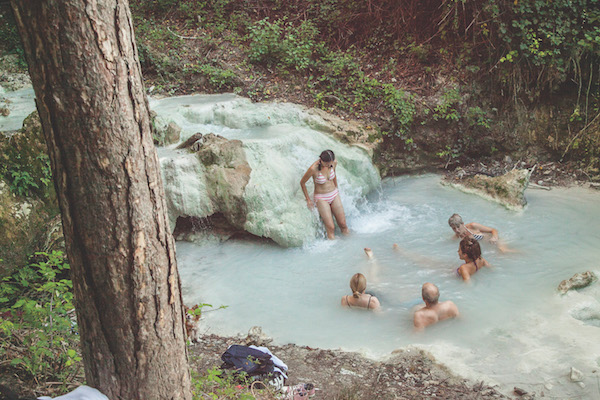
Rushing water
By now I was getting slightly tired. Despite the electronics on the bike, certain efforts are still required to keep the wheels rolling, so when I heard the distant roar of rushing water, I was happy that muscle relief was on its way.
Thermal water can be found on volcanoes all over the world, and there are five different natural hot springs around Mount Amiata, but the most spectacular is the Terme di Bagni San Filippo. Nicknamed the ‘White Whale’ for its calcified structure, this sulphuric spring cascades over layers of crystal-like limestone formation into small pools at its base that are just perfect for wild bathing.
As I sit in the milky white water, feeling a natural calm come over me, I begin to understand the respect that locals have for this mountain. This is truly the mother mountain. Not only does Amiata protect and shelter, she also feeds and nourishes.
On our last day, after we have packed away the bikes for the last time, we meet on the summit of Amiata for an evening aperitif. Under the towering iron cross monument that somewhat resembles the Eiffel Tower, I meditate on the view over the surrounding valley with a glass of prosecco in hand.
“So, what do you think?” Asked Silvia on our return to the hotel after another glorious day of exploring. “Do you like the e-bike now?”
“Yes,” I laughed. “Yes I do!”
The more time I spend on the bike, the less I think it’s cheating. The availability of e-bikes means those who may not normally consider themselves active can also enjoy the thrill of cycling, without the necessary effort. Also, as it turns out, mountain biking is a lot harder than I thought, and having a e-bike meant I could concentrate on having fun, rather than the physical effort required to conquer the rocky ascents and descents of the trails. And what a way for me to experience Mount Amiata!
After all, you can’t always be sipping wine and watching the sunset. Even in Tuscany.
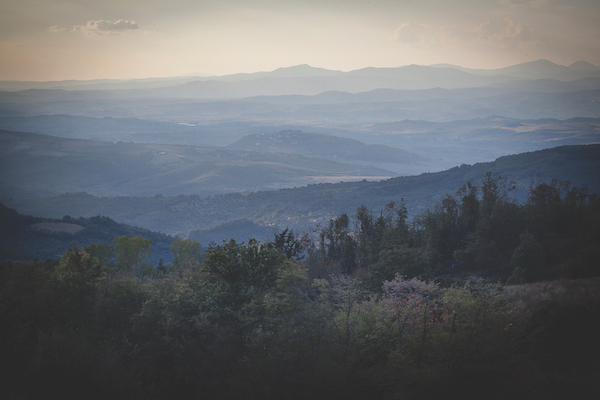
More information
Mountain bike hire
Amiata Freeride offers bike hire, lessons for both children and adults, as well as tours in the Mount Amiata region. There is also a bike park for those who wish to test out their mountain biking skills.
Le Macinaie
Le Macinaie is located on the cross roads of Amiata close to the summit, with convenient access to all that Mount Amiata has to provide. The hotel offers friendly and welcoming hospitality with modest rooms and home-style cuisine, and is right across the road from Amiata Freeride for all the cycling convenience.
Find out more
Tuscany Cycling Season The events, people, stories and landscapes that shape cycling culture in Tuscany.
Terre di Siena Information and tourism service for the area.
Find more inspiration for e-biking holidays in Italy here
